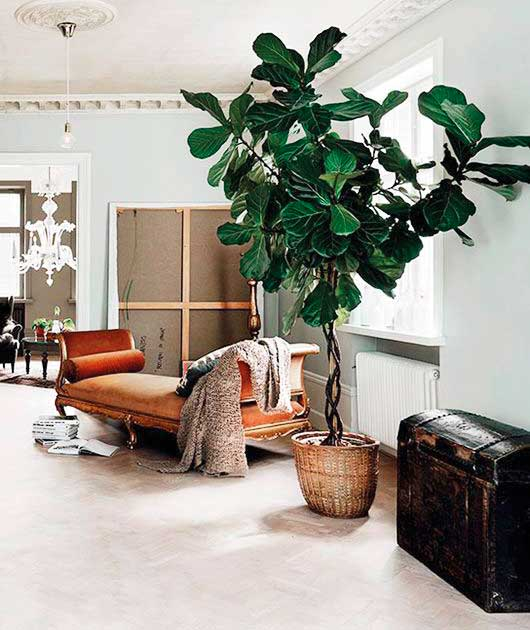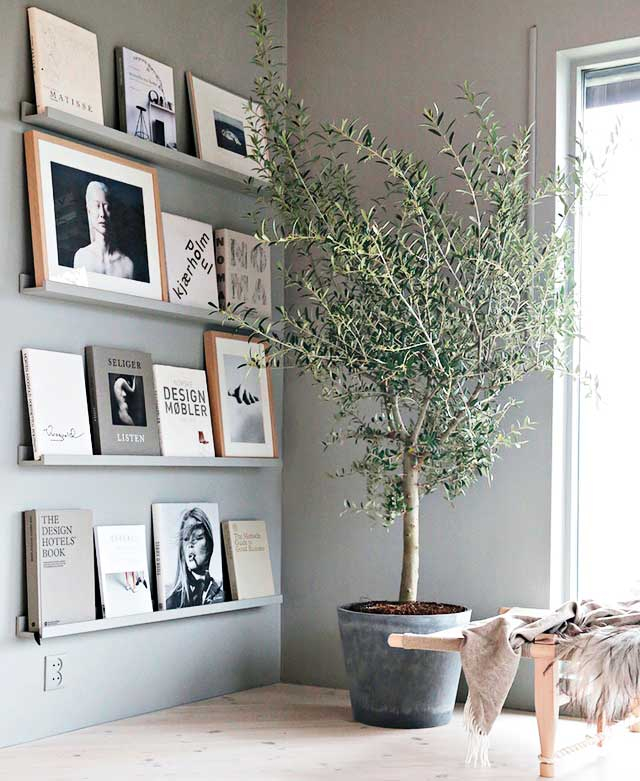Unless you’ve been living under a rock, you would know, the hottest interior accessory for the year is the indoor plant. Now, from personal experience, I can tell you this might just be the most difficult trend to master. Unlike a bad decision in crockery, the wrong plant can’t be confined to the back of your cabinet. More importantly, it is a living thing; care and caution are imperative if you want to enjoy them at home.
A TALL ORDER
Oversized indoor beauties instantly alter our perception of space and volume of our homes, while creating a magical focal point in the room. Even one big plant is enough to make a bold statement. From the humble rubber plant with its’ beautiful, shiny foliage and dramatic impact, to ‘Birds of Paradise’, a tropical plant that can grow quite large indoors (and even flower if you are particularly kind to it), there is one impressive snippet of the magical forest for every home and green thumb of every ability level.
The grey-green palette of the Olive tree, its easily compacted topiary, a range of scale and sturdy nature makes it quite the statement piece in the region. If your indoors are flooded with light, try your hand at Citrus trees, if only for their subtle fragrance. For beginners, a Fig or a Fiddle Leaf fig will ease you into the world of large indoor green friends.
THE SMALL OF IT
Small house plants are easy to work around and as you must have inferred, take less space. From the showy Anthurium and Peace Lillies to hearty Peperomia and English Ivy, there is a wide array of small scale house plants to take home.
For beginners, the safest bet of course, is Cacti. They are the most hard wearing, low maintenance of indoor flora. You can chose from a vast variety — short or tall, flowering or non-flowering. Best arranged in groups, these succulents look best, unsurprisingly, against a Moorish palette of pastels and black metal. Either way, it would take a genius to mess up a cactus.
If you can commit to the maintenance asparagus and ferns demand, you can create a vertical garden indoors. Simply plant the greens into baskets — in metal or wicker — and suspended from the ceiling or safely position atop high cabinets.
THE ESSENTIALS
A Squirting Bottle. Easily available at IKEA and ACE Hardware, this little bottle with a nozzle helps you regularly mist the air. A smart way to hydrate the plants without causing a mess indoors, it also helps raise the humidity inside: good for both you and your plant.
The Drip Tray. To avoid water stagnation, always try to pot your plants in containers that have holes at the bottom. As the water seeps through the soil, a tray will help keep things under control, effectively containing any spills. Especially recommended for small plants and orchids.
A Dust Cloth. As your plants help clean the air, dust is bound to stick to their leaves. That is not a good look, nor is it healthy for the plant as dust blocks the leaves’ pores. A regular dust down keeps the circulation going.
THE INVESTMENTS
Plinths & Pots. It doesn’t take a stylist to figure out, everything looks better when the look is layered. When it comes to plants, we want to play with heights, textures, colours and patterns. Arrange plinths or stools of varying heights to create depth. An array of materials — metals, wood, ceramic, wicker — both for plinths and pots adds to the visual appeal.
Shelf It. Wooden, or metal shelves are ideal for smaller potted plants. If Pinterest is any indicator of popular taste, colour coded bookshelves have been ousted by an entire spectrum of greens, neatly arrange on their perch by the wall.
The Plant Bureau. Browsing through their Instagram profile, it is clear these Dubai-based experts on all things indoor plants know, not only how to take care of your plants, but also help in sourcing the most luscious greens that might not be locally available. Add to that, their styling and maintenance services, and you can have it all without the fuss.











